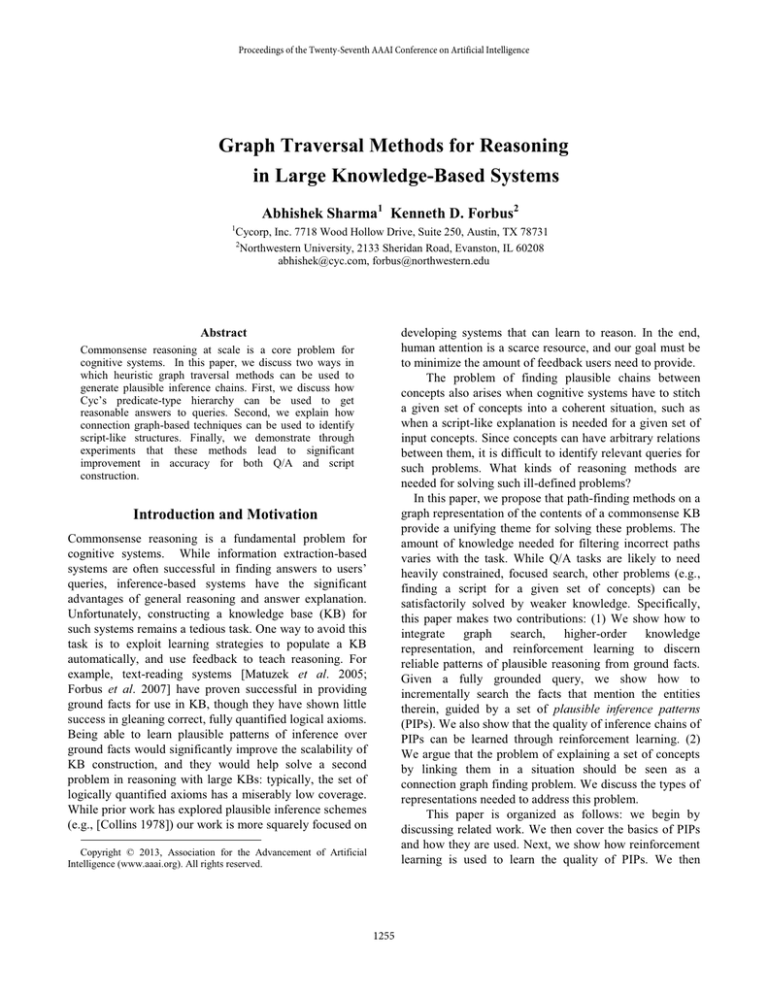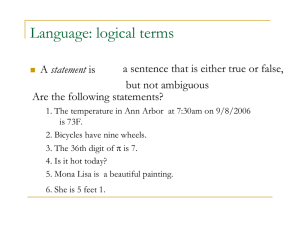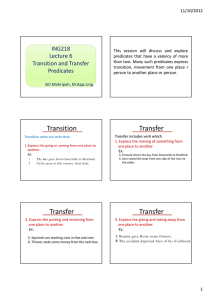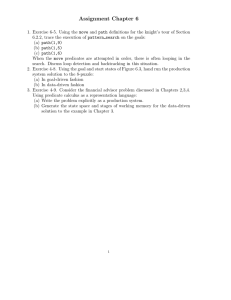
Proceedings of the Twenty-Seventh AAAI Conference on Artificial Intelligence
Graph Traversal Methods for Reasoning
in Large Knowledge-Based Systems
Abhishek Sharma1 Kenneth D. Forbus2
1
Cycorp, Inc. 7718 Wood Hollow Drive, Suite 250, Austin, TX 78731
2
Northwestern University, 2133 Sheridan Road, Evanston, IL 60208
abhishek@cyc.com, forbus@northwestern.edu
developing systems that can learn to reason. In the end,
human attention is a scarce resource, and our goal must be
to minimize the amount of feedback users need to provide.
The problem of finding plausible chains between
concepts also arises when cognitive systems have to stitch
a given set of concepts into a coherent situation, such as
when a script-like explanation is needed for a given set of
input concepts. Since concepts can have arbitrary relations
between them, it is difficult to identify relevant queries for
such problems. What kinds of reasoning methods are
needed for solving such ill-defined problems?
In this paper, we propose that path-finding methods on a
graph representation of the contents of a commonsense KB
provide a unifying theme for solving these problems. The
amount of knowledge needed for filtering incorrect paths
varies with the task. While Q/A tasks are likely to need
heavily constrained, focused search, other problems (e.g.,
finding a script for a given set of concepts) can be
satisfactorily solved by weaker knowledge. Specifically,
this paper makes two contributions: (1) We show how to
integrate graph search, higher-order knowledge
representation, and reinforcement learning to discern
reliable patterns of plausible reasoning from ground facts.
Given a fully grounded query, we show how to
incrementally search the facts that mention the entities
therein, guided by a set of plausible inference patterns
(PIPs). We also show that the quality of inference chains of
PIPs can be learned through reinforcement learning. (2)
We argue that the problem of explaining a set of concepts
by linking them in a situation should be seen as a
connection graph finding problem. We discuss the types of
representations needed to address this problem.
This paper is organized as follows: we begin by
discussing related work. We then cover the basics of PIPs
and how they are used. Next, we show how reinforcement
learning is used to learn the quality of PIPs. We then
Abstract
Commonsense reasoning at scale is a core problem for
cognitive systems. In this paper, we discuss two ways in
which heuristic graph traversal methods can be used to
generate plausible inference chains. First, we discuss how
Cyc’s predicate-type hierarchy can be used to get
reasonable answers to queries. Second, we explain how
connection graph-based techniques can be used to identify
script-like structures. Finally, we demonstrate through
experiments that these methods lead to significant
improvement in accuracy for both Q/A and script
construction.
Introduction and Motivation
Commonsense reasoning is a fundamental problem for
cognitive systems. While information extraction-based
systems are often successful in finding answers to users’
queries, inference-based systems have the significant
advantages of general reasoning and answer explanation.
Unfortunately, constructing a knowledge base (KB) for
such systems remains a tedious task. One way to avoid this
task is to exploit learning strategies to populate a KB
automatically, and use feedback to teach reasoning. For
example, text-reading systems [Matuzek et al. 2005;
Forbus et al. 2007] have proven successful in providing
ground facts for use in KB, though they have shown little
success in gleaning correct, fully quantified logical axioms.
Being able to learn plausible patterns of inference over
ground facts would significantly improve the scalability of
KB construction, and they would help solve a second
problem in reasoning with large KBs: typically, the set of
logically quantified axioms has a miserably low coverage.
While prior work has explored plausible inference schemes
(e.g., [Collins 1978]) our work is more squarely focused on
Copyright © 2013, Association for the Advancement of Artificial
Intelligence (www.aaai.org). All rights reserved.
1255
describe our connection graph-based algorithm for
identifying scripts. Next, we present experimental results.
We conclude by discussing future work.
include TemporalPartPredicate, SpatialPredicate, and
PropositionalAttitudeSlot.
The task of answering questions without using logically
quantified axioms is difficult because it requires sifting
through any number of arbitrary relations between
predicates, any one of which could explain the query. To
avoid this, we have chosen the simpler approach of
building a small sub-graph of relations around the entities
in the query and then assessing the quality of inference
chains between them. This intuition is similar to
connection graphs [Faloutsos et al. 2004] and relational
pathfinding, where the domain is viewed as a (possibly
infinite) graph of constants linked by the relations that hold
between the constants [Richards & Mooney 1992]. More
formally, the KB can be seen as a graph G = (V, E) where
V is the set of nodes (or constants) and E is the set of
edges. An edge, e, exists between two nodes v1 and v2 if
e(v1, v2) or e(v2, v1) are true in the KB. A path from vertex
a to b is an ordered sequence a = v0.v1.v2…vm = b of
distinct vertices in which each adjacent pair (vj-1, vj) is
linked by an edge. Since prior knowledge is important for
biasing learning, we leverage existing axioms in the KB to
create PIPs that are used to keep only the more likely
inference chains. These PIPs are created by replacing
predicates in axioms by their predicate types. PIPs are
accepted if they are generated by more than N axioms. (In
this work, N = 5). We provide a concrete example for
illustration.
Let us assume that the system has been asked to provide
a plausible inference for the query (acquaintedWith
BillClinton HillaryClinton). A small section of the KB
relevant to answering this query is shown in Figure 1. For
simplicity, let us assume that we have just one PIP:
Related Work
A number of researchers from the fields of information
retrieval, natural language processing, databases and
logical inference have contributed to the advancement of
QA technologies [Brill et al. 2002] [Prager et al. 2004].
Overviews of QA techniques can be found in [Belduccinni
et al. 2008, Molla and Vicedo 2007], and a comparison of
challenging problems and approaches has been discussed
in a recent IBM report [Ferrucci et al. 2009]. Learning
surface patterns from natural language text has also been
discussed in [Molla 2006]. Our work differs from this in
that we are trying to improve the performance of a
plausible inference-based Q/A system by learning to
reason. We note that other frameworks for learning to
reason have been explored in [Khardon 1999], but their
efficacy in improving Q/A performance is not known.
Reinforcement learning has been used for learning control
rules for guiding inference in ResearchCyc KB [Taylor et
al. 2007], but to the best of our knowledge, there has been
no prior work to develop a method for providing plausible
explanations for queries (without using logically quantified
axioms) using a learning framework. Similarly, although
there has been work on script identification [Miikkulainen
1990] and event detection [Moore & Essa 2002], we are
not aware of any system which uses a path-finding
approach for producing script-like explanations.
Representation and Reasoning
FamilyRelationSlot(?x,?y) AND FamilyRelationSlot(?y,?z) →
PersonalAssociationPredicate(?x,?z) [PIP1]
Our major source of KB contents is Cyc, and so we have
chosen to adopt key Cyc conventions in this paper. We
summarize those conventions here [Matuszek et al. 2006].
Cyc represents concepts as collections. Each collection
is a kind or type of thing whose instances share a certain
property, attribute, or feature. For example, Cat is the
collection of all and only cats. Collections are arranged
hierarchically by the genls relation. (genls <sub>
<super>) means that anything that is an instance of <sub>
is also an instance of <super>. Predicates are also arranged
in hierarchies. In Cyc terminology, (genlPreds <s> <g>)
means that <g> is a generalization of <s>. We
make
extensive use of Cyc’s predicate type hierarchy.
PredicateType is a collection of collections and each
instance of PredicateType is a collection of predicates. The
predicates in a given predicate category represented in the
KB are typically those sharing some common feature(s)
considered significant enough that the collection of all such
predicates is useful to include. Instances of PredicateType
father
ChelseaClinton
dau
daughter
BillClinton
“Clinton”
familyName
yName
HillaryClinton
ffamilyName
Figure 1: Plausible Inference Example.
This pattern represents the knowledge that two
predicates of type FamilyRelationSlot can plausibly
combine to infer assertions involving personal
associations. This representation has been chosen because
we believe that predicate types such as SubEventPredicate,
PhysicalPartPredicate, and CausalityPredicate provide a
meaningful level of abstraction for identifying PIPs. For
instance, all predicates of type SubEventPredicate can be
1256
used for proving eventPartiallyOccursAt queries1.
Similarly, all predicates of type PhysicalPartPredicate are
relevant for proving objectFoundInLocation queries2.
Therefore, learning knowledge in terms of predicate types
is easier and more natural.
for this query would be found by querying for (p ?x
BillClinton) where p is an instance of FamilyRelationSlot.
An assertion as (father ChelseaClinton BillClinton) would
be a solution for this query. This would lead to a query as
FamilyRelationSlot (ChelseaClinton , HillaryClinton),
which would be answered with the help of facts like
(mother ChelseaClinton HillaryClinton). In Figure 1, the
second path involving two edges labeled ‘familyName’
would not be selected because no PIPs use predicates of
type
ProperNamePredicate-Strict
to
entail
PersonalAssociationPredicate predicates. Similarly, the
following
PIP
would
help
in
proving
(objectFoundInLocation
ArmyBase-Grounds-FtShafterOahu HawaiianIslands) (see Figure 3):
SpatialPredicate(?x, ?y) AND Group-Topic(?z,?y) →
SpatialPredicate(?x, ?z)
… [PIP2]
The pattern PIP2 shown above would lead to an incorrect
answer if we use bordersOn as an instance of
SpatialPredicate in the consequent. In the next section, we
discuss how reinforcement learning helps us in solving this
problem.
Algorithm: find-plausible-explanations: FPE(KB, query)
Input: query: A ground query
Local Variable: solutions initialized to {}.
Output: A set of facts which would justify query.
1.
2.
3.
4.
5.
6.
7.
8.
9.
10.
11.
12.
13.
14.
for all patterns r in KB, where r =
{p1 ^ p2 ^ ...^ pn → q}
type ← predicate type in q.
pred ← predicate in query
if (isa pred type) then
θ´ ← unify the variables in q and query.
for j ← 1 to n
queryj ← substitute bindings from θ´ in pj.
Solutionj ← find solutions for queryj.
if bindings from Solutionsj are consistent then
update θ´ else goto step 12.
end for
If Solutionj exists for all 1≤ j ≤ n then update
solutions
end if
end for
return solutions.
HawaiianIslands
groupMembers
ArmyBase-Grounds-FtShafter-Oahu
objectFoundInLocation
ocation
Oahu-Island-Hawaii
Figure 2: Algorithm for finding plausible explanations
Figure 3: Another plausible inference example.
This inference scheme also simplifies inference by
condensing inference chains. For example, wife is a
PersonalAssociationPredicate, and so the inference from
wife to acquaintedWith is a one-step process. On the other
hand, using the normal predicate hierarchy involves multistep inferences. The inference chain from wife to
acquaintedWith, for example, is a four-step reasoning
chain3. Since the number of predicate types is less than the
number of predicates, the predicate type hierarchy maps
the predicates to a smaller space. This speeds up the search
because the average path length between two nodes in this
smaller space is less than what we encounter in a typical
predicate hierarchy. This plays an important role in
improving inference. The FPE algorithm can be easily
extended to handle queries with variables. This would
entail checking that the node at the search frontier satisfies
the argument constraint of the predicate.
The relative tractability of this formulation can also be
seen when noting the difference between the sizes of
search spaces. Learning to distinguish between correct and
incorrect derivations of length k involves searching in a
space of size Nk, where N is the size of vocabulary. In Cyc,
the number of predicates is 24 times larger than the number
of predicate types. Therefore, learning PIPs in terms of
predicate types is significantly easier. The algorithm findplausible-explanations is described in Figure 2. In the
example introduced above, r would be bound to PIP1 in
step
1.
In
step
2,
type
is
bound
to
PersonalAssociationPredicate.
Since
the
predicate
acquaintedWith is an instance of this collection, the test in
step 4 succeeds, and we try to prove the antecedents of the
rule in steps 6–10. Essentially, this means that we are
looking for a path between the nodes labeled BillClinton
and HillaryClinton traversing two edges labeled with
predicates of type FamilyRelationSlot. In Figure 1, a small
section of the graph is shown. In step 7, we create a query
FamilyRelationSlot(?x, BillClinton). In step 8, solutions
Learning to Reason
Many learning systems learn the correct level of
generalization by trial and error. Our approach gets initial
1
Some examples of SubEventPredicate predicates are firstSubEvents,
cotemporalSubEvents, finalSubEvents etc.
2
Some examples of PhysicalPartPredicate are physicalParts, internalParts,
northernRegion etc.
3
The four steps are acquaintedWith → mutualAcquaintances → mate →
spouse → wife.
1257
PIPs by replacing predicates in axioms with their predicate
types. These generalizations certainly increase the
deductive closure but can lead to incorrect answers.
The task of designing a system that could learn to
identify incorrect search steps from minimal user feedback
is complicated by the fact that a typical user may not be
able to identify the incorrect search choice(s) made during
a multistep reasoning process. Thus, the learner ought to be
able to work with delayed feedback about the correctness
of the final answer and learn to find plausible inferences
for queries. We believe that reinforcement learning is a
reasonable method for solving this problem. Formally, the
model consists of (a) a discrete set of states, S; (b) a
discrete set of agent actions, A; (c) a reward function R: S
× A → {-1, 1}; and (d) a state transition function T: S × A
→ ∏(S), where a member of ∏(S) is a probability
distribution over the set S [Kaelbling et al. 1996]. In this
context, a state is the list of predicate types already used
during the partially complete search process. At each step
of the reasoning process, the inference engine has choice
points at which it chooses or rejects different alternatives.
To do this, it must assess how useful a particular predicate
type is for completing the proof given the predicate types
already chosen in the current search path. The actions are
the selection of a particular predicate type for completing
the partial assignment of variables. The value function (or
V(s)) is the inference engine’s current mapping from the
set of possible states to its estimates of the long-term
reward to be expected after visiting a state and continuing
the search with the same policy. Q(s, a) represents the
value of taking the action a in state s. We use the value
iteration algorithm [Kaelbling et al. 1996] for learning the
plausibility of search paths, and a delayed reward model
with user-provided rewards of +1 and -1 for correct and
incorrect answers, respectively.
Output: A connected subgraph containing S and at most
n other nodes, that maximizes a goodness criterion.
Input:
[BlowingOutCandles,
EatingEvent]
Applauding-Clapping,
Relevant Facts:
(properSubEventTypes
LightingTheCandlesOnABirthdayCake LightingACandle)
(preconditionFor-EventTypeEventType BlowingOutCandles
LightingACandle)
(properSubEventTypes BirthdayParty
LightingTheCandlesOnABirthdayCake)
(candidateProperSubSituationTypes BirthdayParty
ApplaudingTheBlowingOutOfBirthdayCakeCandles)
(properSubEventTypes
ApplaudingTheBlowingOutOfBirthdayCakeCandles
Applauding-Clapping)
(properSubEventTypes BirthdayParty
ServingTheCakeToGuests)
(superEventTypes ServingTheCakeToGuests
CelebratoryEatingOfTheCake)
(properSubEventTypes CelebratoryEatingOfTheCake
EatingEvent)
Figure 4: A Sample Output
For example, given an input like {BlowingOutCandles,
Applauding-Clapping, EatingEvent}, we would like to
infer that the situation refers to a birthday party and explain
why these features are related to it (See Figure 4). Our
method for finding a connection graph is based on work in
the knowledge discovery community [Faloutsos et al.
2004, Ramakrishnan et al. 2005]. We describe their
approach in brief here. The algorithm has two central
components: (1) a candidate generation algorithm, and (2)
a display generation component. The candidate generation
component maintains a list of pending nodes and expands
the frontiers of the graph starting from a given set of nodes.
The display generation component [Faloutsos et al. 2004]
aims to identify a small subset of nodes and edges that
represent the most relevant relation between the input
nodes, using the model of an electrical circuit. A modified
version of this algorithm is shown in Figure 5. The input to
the algorithm is a set of concepts. It also uses a set of
useful predicates, P, and a set of inconsistent path patterns,
Q. The set P contains predicates that are more useful for
representing semantic information4. Consider the example
shown in Figure 4. In steps 1-6 of the algorithm shown in
Figure 5, we create a graph around the input concepts. For
example, the query in step 3 would look like
(properSubEventTypes ?x BlowingOutCandles). The
Connection Graph Methods for Identifying
Script-like Structures
In many AI applications, we need to find a small set of
assertions that best capture the relationships between a set
of concepts. The primary aim is to stitch the concepts
together in a script by adding missing relations between
them. Here we discuss the different knowledge
representation and reasoning challenges that must be
addressed to solve this problem. As discussed above, we
represent the contents of the KB as a graph, where
concepts are nodes and edges represent relations between
them. Given such a structure, the problem can be
formulated as:
Input: An edge-weighted undirected graph G, a set of
concepts S = {S1, …, SN}, and an integer budget n.
4
We used this set to exclude bookkeeping and NL predicates (e.g.,
nameString). properSubEventTypes, eventTypeOccursAtLocationType,
and typePrimaryFunction are some elements of P.
1258
results from the query are added to the graph in step 4. In
step 7, we use the display generation algorithm for
extracting a small connection graph. This involves using
dynamic programming and a model of an electrical circuit
to identify most relevant paths between the input nodes
[Faloutsos et al. 2004]. This might be sufficient for lightly
constrained domains, but this approach becomes less useful
in a domain where more semantic processing is needed.
Therefore, we augment the algorithm with a postprocessing step (step 8) which prunes implausible paths in
the graph. A set of implausible path patterns, Q, is an input
to the algorithm. For example, a pattern of the type
(eventTypeOccursAtLocationType
?x
?y)
AND
(eventTypeOccursAtLocationType ?z ?y) would represent
the fact that sharing a common location type is less useful
for finding connections between script constituents. This
would ensure that we do not hypothesize a link between
RoadConstructing and IceClimbing just because they occur
outdoors. If all concepts in the input are not in a connected
component of the pruned graph, then we repeat the step
with a relaxed size constraint (step 12).
Where is <GeographicalRegion>? Each question template
expands to a disjunction of formal queries. Queries were
generated by randomly selecting facts for these questions
from the KB. For a baseline comparison, we included all
axioms for these predicates and their subgoals to a depth of
3. We used a simple backchainer working on an LTMSbased inference engine [Forbus & de Kleer, 1993]. The
depth of backchaining was also limited to three and each
query was timed out after three minutes. All experiments
were performed on a 3.2 GHz Pentium Xeon processor
with 3GB of RAM. 25% of the queries were used as the
training set for learning the V(s) values. Answers whose
V(s) values were more than a threshold were accepted.
Table 1 compares the performance of the FPE algorithm
and reinforcement learning against the baseline for the test
set (i.e. the remaining 75% of queries). Each experiment
corresponds to queries from a particular template (i.e.,
Expt. 1 concerns the location of events). Column T is the
total number of queries, and AW is the number that could
be answered given the KB contents, as determined by hand
inspection. The columns P and R indicate precision and
recall, respectively. The user assessed 334 unique answers
(from the training set) and the feedback was used for
learning the V(s) values. The accuracy of answers provided
by the FPE algorithm was 73%. We then removed answers
whose V(s) values were below the threshold. The total
number of new answers at this stage was 1010 and the
accuracy improved from 73% to 94%. The FPE algorithm
mainly reduces false negatives, whereas reinforcement
learning reduces false positives. Together, they improve on
the baseline by a factor of 2.2 (i.e. by 120%) with an
average accuracy of 94%. The results shown in Table 1 are
statistically significant (p < 0.01).
Algorithm: find-plausible-script (FPS)
Input: A set of input concepts: S, A set of predicates: P, A
set of filtered paths: Q, An integer budget: N
1.
2.
3.
4.
5.
6.
7.
for each concept c belonging to S
for each predicate p belonging to P
Retrieve all facts involving p and c
Add the nodes to the graph
end for
end for
OutputGraph ← Use display generation
algorithm to extract a connection graph of size N
8. PrunedGraph ← Remove all edges from
OutputGraph which are inconsistent with Q.
9. if all elements of S are in a component then
10.
return PrunedGraph
11. else
12.
set N ← N+1 and goto step 1.
Exp.
No.
1
2
3
Figure 5: Algorithm for identifying script-like structures
4
Experimental Method and Results
5.
To show that these ideas generate more answers compared
to traditional deductive reasoning methods, we conducted a
set of experiments. Five sets of questions were selected
based on the availability of ground facts in KB and their
relevance in learning by reading [Forbus et al 2007]. These
questions’ templates were (1) Where did <Event> occur?
(2) Who is affected by <Event>? (3) Where is
<SpatialThing>? (4) Who performed the <Event>? and (5)
Query
sets
Baseline
FPE
Baseline
FPE
Baseline
FPE
Baseline
FPE
Baseline
FPE
T
AW
833
833
200
200
1834
1834
953
953
1309
1309
412
412
61
61
433
433
226
226
724
724
P
1.00
0.95
1.00
0.92
1.00
0.92
1.00
0.93
1.00
0.97
R
0.51
0.87
0.42
0.77
0.32
0.88
0.34
0.93
0.43
0.94
Table 1: Summary of inference results. Experiment
numbers are the same as query numbers.
To evaluate the script recognition system, we used the
algorithm for comprehending events in videos. A computer
1259
vision and speech recognition system was used to generate
low-level features from 103 videos. These features are
mapped to the collections from the knowledge base, such
as the collections marked as input in Figure 4. These
features were fed to the algorithm shown in Figure 5. The
scripts in videos were roughly divided into following five
types: (1) wedding event, (2) skateboarding (3) making a
sandwich, (4) flash mob and (5) parkour. The sixth script
type includes all scripts which were different from five
types mentioned above. The first column in Table 2 shows
these script numbers. In the third column, we report the
proportion of facts in the output which were directly
relevant for understanding the script. Since we are
evaluating the efficacy of connection-graph methods for
this problem, we can establish our baseline by replacing
steps 7 and 8 in Figure 5 with an algorithm that finds the
shortest paths between the nodes in the input. The results
shown in Table 2 are statistically significant (p < 0.01).
Script
Type
1
2
3
4
5
6
Method
Baseline
FPS
Baseline
FPS
Baseline
FPS
Baseline
FPS
Baseline
FPS
Baseline
FPS
%
correct
69.0
96.0
67.4
84.6
61.9
89.0
50.0
100.0
33.5
93.0
25.6
49.0
gather than logically quantified facts. We believe that this
technique can be used to help bootstrap intelligent systems
and reduce dependence on handcrafted axioms. Our results
suggest following further lines of work. For one, being
able to refine PIPs to use more specific predicate types
would improve accuracy and coverage. In addition, PIPs
could be used as an intermediate stage for postulating new
logically quantified statements, perhaps by using a
technique like relational reinforcement learning [Dzeroski
et al. 2001] to carry out the refinements.
Our work on identifying scripts can be extended in at
least four ways. Firstly, scripts often have temporal
dependencies between their events, and we would like to
include temporal constraint processing in our model.
Secondly, though we have used a list of implausible
patterns to prune less useful paths, we believe this
approach can be improved by employing a grammar of
plausible paths [Navigli 2008]. Thirdly, we should try to
remove the stricture that all concepts be part of a connected
component. For example, concepts like Sun and Night
might be present in many video events. Although it is
possible to connect such concepts to different events in a
given video, we believe that we might need to prune those
input concepts that have low estimates of information gain.
Finally, we have found that correct paths might not be
available in the search space due to two reasons: (a) The
KB might not have relevant knowledge5 or (b) The system
is not considering relevant predicates due to resource
constraints. Due to the absence of correct paths, the
algorithm might connect concepts via overly general
nodes. We would like to detect and prune such incorrect
paths.
Improvement
w.r.t. baseline
39%
25%
44%
100%
177%
91%
Table 2: Evaluation of find-plausible-script (FPS) algorithm
Acknowledgements
This work benefited from discussions with Doug Lenat.
This work was supported by the Office of Naval Research.
Conclusion
Plausible commonsense reasoning is a fundamental
problem for cognitive systems, and we believe that our
approach provides a promising solution. We have shown
how different graph traversal methods can be used to
alleviate the difficulties created by missing knowledge.
The use of predicate types for representing PIPs leads to a
succinct, easily learnable and tractable representation. With
the FPE algorithm mainly reducing false negatives, and
reinforcement learning reducing false positives, we get a
120% improvement over the baseline with an average
accuracy of 94%. The use of connection graph methods of
identifying script-like explanations produces good results.
While these experiments used the contents of
ResearchCyc, we believe they are applicable to any largescale KB whose predicate types were classified sensibly.
Our technique is especially suitable for knowledge capture
because it exploits ground facts, which are much easier to
References
Belduccinni, M. Baral, C. and Lierler, Y. 2008. Knowledge
Representation and Question Answering. In Vladimir Lifschitz
and Frank van Harmelen and Bruce Porter, ed In Handbook of
Knowledge Representation.
Brill, E., Dumais, S. and Banko, M. 2002. An analysis of the
AskMSR question-answering system. Proceedings of ACL, pages
257-264.
Clark, P., Thompson, J. and Porter, B. 2000 Knowledge Patterns.
Proceedings of KR, page 591-600.
Collins, A. 1978. Human Plausible Reasoning. BBN Report No.
3810.
5
Lack of relevant knowledge in KB is the primary reason
behind relatively low numbers for Script type 6 in Table 2.
1260
Dzeroski, S., de Raedt, L. and Driessens, K. 2001 Relational
Reinforcement Learning. Machine Learning, 43, pp. 7-52
Faloutsos, C., McCurley, K. S. and Tomkins, A. 2004 Fast
Discovery of Connection Subgraphs. Proceedings of KDD, pages
118-127.
Ferrucci, F. and Nyberg, E. et al 2009 Towards the Open
Advancement of Question Answering Systems. IBM Research
Report. RC24789 (W0904-093), IBM Research, New York.
Forbus, K. D. and de Kleer, J. 1993 Building Problem Solvers.
MIT Press
Forbus, K. D., Riesbeck, C., Birnbaum, L., Livingston, K.,
Sharma A., and Ureel, L. (2007). Integrating Natural Language,
Knowledge Representation and Reasoning, and Analogical
Processing to Learn by Reading. Proceedings of AAAI, pages
1542-1547
Khardon, R. 1999 Learning Function-Free Horn Expressions.
Machine Learning, 37, pp. 241-275.
Kaelbling, L. P., Littman, M. and Moore, A. 1996. Reinforcement
Learning: A Survey. Journal of AI Research, 4, pp. 237-285.
Matuszek, C., Witbrock, M., Kahlert, R., Cabral, J., Schneider,
D., Shaw, P., and Lenat, D. 2005. Searching for common sense:
Populating Cyc from the web. Proceedings of AAAI, pages 14301435.
Matuszek, C., Cabral, J., Witbrock, M. and De Olivieira, J. 2006.
An Introduction to the Syntax and Content of Cyc. AAAI Spring
Symposium, pages 44-49.
Miikkulainen, R. 1990. Script Recognition with Hierarchical
Feature Maps. Connection Science, pages 83-101
Molla, D. 2006 Learning of Graph-based Question Answering
Rules. Proceedings of HLT/NAACL Workshop on Graph
Algorithms for Natural Language Processing. pages 37-44.
Molla, D. and Vicedo, J. L. 2007. Question Answering in
Restricted Domains: An Overview. Computational Linguistics, 33
(1), pp. 41-61
Moore, D. and I. Essa. 2002. Recognizing Multitasked Activities
from Video Using Stochastic Context-Free Grammar,
Proceedings of AAAI, pages 770-776.
Navigli, R. 2008. A Structural Approach to the Automatic
Adjudication of Word-Sense Disagreements. Natural Language
Engineering. Vol. 14, 4, pp. 547-573
Prager, J., Chu-Carroll, J. and Czuba, K. 2004. Question
Answering Using Constraint Satisfaction: QA-by-Dossier-withConstraints. Proceedings of ACL, pages 60-65.
Ramakrishnan, S., Milnor, W. H., Perry, M. and Sheth, A. 2005.
Discovering Informative Connection Subgraphs in Mutirelational Graphs. ACM SIGKDD Explorations Newsletter, 7(2),
pp. 56-63.
Richards, B. and Mooney, R. 1992. Learning Relations by
Pathfinding. Proceedings of AAAI, pages 50-55.
Taylor, M., Matuszek, C., Smith, P. and Witbrock, M. 2007.
Guiding Inference with Policy Search Reinforcement Learning.
Proceedings of FLAIRS, pages 146-151.
1261






